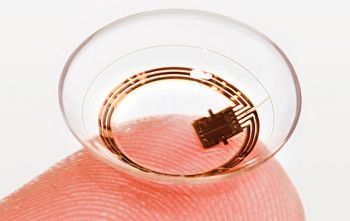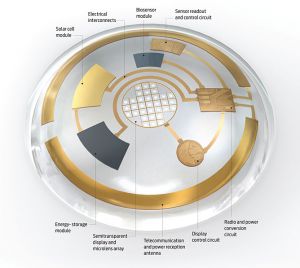Engineers are discovering modern applications of the contact lens, extending from correcting vision to curing blindness. Intraocular pressure sensors in contact lenses may provide relief to glaucoma patients; stem cell colonies from a healthy eye may, when applied to a lens, help repair vision loss. Contact lenses are also the subject of nanotechnology experiments, including applications not only to medicine but also to virtual reality: overlaying the digital and physical world within a field of vision is an old idea, but the different functions of such technology in the contact lens are quite innovative. From controlling the eye’s natural focusing ability to operating a fully-functioning phone, such augmented reality technologies could be integrated into an everyday lens.
Introduction
If you do not own contact lenses, you might still easily envision their size: if you were to hold a single contact lens, it would be barely bigger than the tip of your finger. Now imagine that contact lens accommodating a radio, an LED display, and an antenna and control circuit as well as the simple ability to tint, acting as replacements for sunglasses. Our world is rapidly making leaping advancements in technology, constantly challenging the minds of innovators to not only generate new ideas, but also to create hybrids of past ideas. Contact lenses with an additional UV protective property, for instance, is one these developing advances. But we are capable of reaching far past simply using contact lenses as sunglasses – we might yet cure blindness or fabricate augmented reality with the technologies applied to the contact lens. The implementation of nanotechnology on an object about 125 million people use on a daily basis worldwide relies, of course, upon the generation of these innovative new ideas [1].
Contact Lens: Basic Types
If you are not one of the lucky people who possess 20/20 vision, you probably instead own a pair of glasses or contact lenses. Both are instruments of visual correction when worn by the user. They specifically aid to correct myopia (nearsightedness), hyperopia (farsightedness), astigmatism (distorted vision), and presbyopia (the need for bifocals). Depending on the user’s condition, a specific type of lens can be chosen. First created in the 1960s, PMMA contact lenses are rigid (or hard). Its material, polymethyl methacrylate (which gives the lens its name) does not allow oxygen to permeate to the cornea. Instead, as the user blinks, the lens shifts, making room for tears with oxygen to contact the cornea. These lenses are quite durable because of the rigid material of which they are made, but because they are uncomfortable, they are the least worn contacts today. Gas-permeable lenses (or RGPs) are also rigid lenses made of newer plastics such as silicone and fluoropolymers. These modern rigid lenses allow oxygen to permeate to the cornea. Since these lenses are still hard in material, they are somewhat uncomfortable to wear, but they are an improvement from the comfort of PMMAs.
The most commonly worn lenses are soft contact lenses, which are constructed from plastic that becomes flexible when in contact with water. Soft lenses are the most comfortable, as they cling and naturally form to surface of the eye due to their malleability. After choosing a lens, a user must select the duration of wear. Contact lenses are created with different life spans, from a single day to a 2-4 week stretch. The toric lens, which corrects astigmatism, often lasts for months. Despite the contact lenses’ somewhat ordinary function, engineers are identifying new opportunities for enhancing lens performance.
UV Protection
The application of ultraviolet protection to sunglasses and glasses is very common and has been used for many years. More recently, the Institute for Bioengineering and Nanotechnology in Singapore began developing a contact lens that carries the same properties as tinted glasses (also called a photochromic lens). When tested in 2009, the dye in the material of the contact lens responded to UV light rather quickly, faster than tinted glasses. The quick transformation, which was accomplished in 10-20 seconds in the contact lenses and several minutes in glasses lenses, is crucial when the light environment suddenly changes – for example, when driving into a tunnel, the driver will need the lens to adjust in order to see clearly [2]. Successfully integrating UV protection into contact lenses could revolutionize the eye wear industry, since photochromic lenses could make the use of sunglasses obsolete. Although “sun-lenses” would be practical, though, most research concerning contact lenses focuses on biomedical applications.
Disease Monitoring
There is currently no complete cure for glaucoma, which is one of the leading causes of blindness in the world. It is a disease that can only be detected in its advanced stages, at which point the individual will have suffered great loss in vision. Glaucoma results from increased pressure from excess fluid in the eye, harming the optic nerve, thus causing gradual blindness. Any treatment is typically applied to minimize further loss of vision. Because glaucoma is a gradually progressing affliction, patients need to be carefully monitored. Engineers are now developing a microchip, embedded into a single contact lens, which monitors fluid pressure in the eye and communicates with a separate device to record the information. Traditionally, patients would need to sleep overnight at a hospital to be woken up every hour to take fluid pressure measurements, but with the use of these lenses, the patient’s fluid pressure can be monitored anytime and anywhere without hospital visits. This method of monitoring is possible because human tears coating the eye contain the same biological cells and data as human blood. Since the detector is directly on the eye, it provides instant and detailed data about the state of glaucoma on the eye, allowing doctors to better diagnose patients [3].
The Swiss medical micro-technology company SENSIMED, a branch of the Swiss Federal Institute of Technology, engineered a contact lens that could perform as a monitor for glaucoma patients in 2011. The Triggerfish® (Fig. 1) includes an embedded sensor in the lens and comes with an antenna (worn on the forehead) that transmits the data to a portable recorder. It constantly checks the intraocular pressure (IOP) of the patient for up to a whole day. Due to its hand-free and portable nature, the user is able to go about with daily activities [4]. By using contact lenses as medical resources, doctors and engineers can expand from just glaucoma monitoring to blood-sugar levels for diabetics, cholesterol levels, and more. The possibilities for this nanotechnology are amazing and would greatly streamline patient monitoring and examinations.
Curing Blindness
Scientists are also taking steps to address the end result of glaucoma: blindness. Nick Di Girolama of the School of Medical Sciences in New South Wales is leading the research of implanting epithelial stem cells (ESC) into contact lenses as a possible remedy for blindness that results from a damaged cornea [5]. In his research, Girolama extracted stem cells from the cornea of a healthy eye and infused them into a special lens. According to his studies, the healthy stem cells should recolonize in the blind eye, repairing the damaged cornea with the same biological data from the healthy eye. Three subjects, each of whom were blind in one eye, were tested with this method and within 10-14 days, Girolama’s hypotheses were proven correct: two subjects, once legally blind, were now able to read part of the eye chart, and the third subject recovered enough to pass a driving test [5]. This method is in its early stages of development, but it shows potential for further medical application.
Augmented Reality
Augmented reality has been represented in films like Terminator and Iron Man, commonly via high-tech glasses or contact lenses. Live data scrolling in front of our eyes, a facial recognition system, video conferencing, and voice activation may all be components in augmented reality that may be implemented through contact lenses. The concept and development of augmented reality has existed for some time, but new doors are opening for the formation of an overlap between the digital and physical worlds. The devices that project augmented reality range from head mounts, eye glasses, virtual retinal displays, and handheld devices, and the contact lens might yet finds its way onto this list.
Babak Parviz, an electrical engineering professor at the University of Washington, is producing a prototype of a contact lens consisting of a 450 nanometer-wide radio (also called a bionic lens). Ultimately, his goal is to develop a full multi-functional contact lens. His research focuses on microsystems integrated into biomedical devices, including a glucose level detector and LED displays in contact lenses. Currently, he has successfully implemented a single pixel LED display onto the lens, which blinks with a red or blue light [6].
Parviz’s contact lens has not quite accessed the full potential of augmented reality, but his foray into LED displays is a start. Although a radio-supporting lens is another of his intended steps towards augmented reality, it proves to be ambitious; as seen in Figure 2, the lens must hold elements like an energy-storage module, a control circuit, a telecommunication antenna, a display circuit, and a radio and power conversion circuit. The success of radio implementation is crucial before attempting to integrate any other elements of augmented reality because it is the chief system of communication between the lens and other devices.
Innovega is a company producing the iOptik™, their own version of augmented reality. Their research in augmented reality and contact lenses focuses on enhancing human vision by allowing the human eye to focus on an object very close or very far away – much like how a camera lens or binoculars perform. While you are focused on an object in the foreground, everything in the background would normally be fuzzy, but while wearing the iOptik™ lens, you can simultaneously focus on both fore and background without any fuzziness. Such an experience is achieved by the delicate engineering of the contact lens. Innovega created an outer and center filter with a display lens (see Fig.5 and 6). Stephen Willey, the CEO of Innovega, explains the physics behind the lens:
“Display light passes through the small central optic which, in combination with the eye’s normal optics, focuses the display light onto the retina. The display light that falls on the outer portion of the contact lens is blocked by the outer filter to prevent it from interfering with the view of the display. Ambient light from the environment is able to pass through the outer filter. This light enters the pupil and is focused onto the retina. Almost half of all consumers benefit from a lens prescription so this is incorporated into the lens. Light from the environment that passes through the center focusing optic is first defocused and is then blocked by the center filter preventing this defocused light from interfering with the wearer’s normal view of the surroundings [7].
Innovega’s iOptik™ design allows the user to focus on the small display onto which the digital world will be projected. Because the user can focus on very close images, it eliminates the use of extra eyewear or devices attached to our bodies in order to read the display, while still allowing us to view the world around us without a substantial adjustment in vision. The design accounts for near- and far-sightedness, or macro- and microvision (not to be confused, though, with microscopic or binocular vision). Just like when taking a picture of a close object, like a flower, the camera lens will focus on the flower, automatically blurring the objects in the background, just as our eyes naturally do. The construction of the iOptik™ lens, however, masks the “blurring” effect, allowing us to focus on anything in our field of vision without actually having to shift focus.
This particular design can also be incorporated into battlefield and combat situations, both training and reality. It is hands-free, lightweight and easy to use, which are crucial features for a soldier on duty when using advanced technology (unlike previously attempted bulky headgear). If this tiny piece of technology was incorporated into military operations, it could greatly advance the presentation of technical data, satellite information, communication, live camera feeds and maps [8]. On a day-to-day civilian basis, features similar to a smartphone could be accessed through the contact lens, like phone calls and messages, a camera, maps, weather data, calendars and possibly a basic internet connection. Everyday tasks like a phone call to a friend could be accomplished just by voice activation, eliminating the need to pull out your mobile device and dial.
Conclusion
As our world progresses further into the technology-dominant age, our lives are continually molded by the world around us. If something as small as contact lens could be embedded with nanotechnology and data, imagine our world a step further. Engineers continually identify new potential operations for the contact lens, ranging from the practical, the cosmetic, and the medical. In both entertainment, health, and combat, technology incorporated into the contact lens may improve our lives in important ways.





